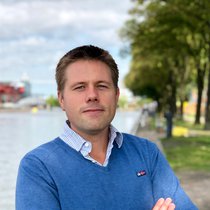A big part of innovation in space technology revolves around finding smart, efficient and circular ways to establish a life support system for the astronauts going on the trip. Since it’s simply impossible to bring an end-less amount of resources on board, how do you make sure the astronauts can eat, drink and breath?
Viewing cities as spaceships
The European Space Agency (ESA) established MELiSSA (Micro-Ecological Life Support System Alternative); an initiative with the aim to conduct research on and to develop technology for circular life support systems for long-term human space missions. It was established to gain knowledge on regenerative systems in space stations, aiming for the highest degree of autonomy possible; consequently to produce food, water and oxygen from astronaut waste.
What if we view “cities as spaceships”; in terms of urban environments being ‘closed-loop systems’? This gives way to the idea that the same space technology developed by ESA could be applied to increase circularity in a city like Amsterdam.
The Space for Food project explores the potential and scalability of applying space technology for applications in urban contexts.
“The objective of MELiSSA is, on one side, to take all the waste of the mission, and on the other side to produce, oxygen, [energy], water and food. So this is the ultimate example of circular economy.”
Christophe Lasseur | Head of MELiSSA Project | ESA (ESTEC)
Towards circular resource streams
Municipal wastewater is a great resource for nutrients and water reuse. The Space for Food project aims to use space technology in recovering nutrients and cleaning wastewater that can be used in food production using vertical farming. Closing the loops from waste to resource will help improving the impact in the environment, while creating resilience for the cities.
For this reason, the project will test a proof of concept using a raceway reactor for purple bacteria cultivation on brewery and municipal yellow wastewater (urine). The biomass will be used as slow release fertilizer and bio-stimulant for cultivation of vegetables.
The aforementioned slow release fertilizer and bio-stimulant for cultivation of vegetables will be tested at a local vertical farm set-up by GROWx – reinforcing this closed loop system.
GROWx 2.0 Robotic vertical farm
Long-term goals and feasibility
The project goal is to have a series of technologies validated for nutrient recovery, water treatment and food production that can serve as circular solution for the cities. The integration of the technology can reach to a high degree of self-sufficiency and resilience for organizations or governments. The products will shorten the supply chain and create resilience in the area with a significant positive impact of the environment and a boost to the local economy.
Previous feasibility study of the technologies proposed was done in 2019 showing a potential for water recovery up to 80% (suitable to be used in irrigation) and nutrient recovery for an output of roughly 2 kg of product (candidate vegetables) per person per day, on the municipal waste stream.
“We're currently running a sanitation pilot in Amsterdam focused on using wastewater to produce biogas and to collect phosphate. Ultimately, to contribute to the goal of houses becoming energy-neutral. In addition, this test at Marineterrein could open up new opportunities to extract other raw materials from wastewater!”
Waternet
Experimenting at Marineterrein Amsterdam Living Lab
The systems will be tested at Marineterrein Amsterdam Living Lab (MALL). This area is being developed into an inner-city test ground where different parties work closely together to develop urban experimentation at Marineterrein Amsterdam.
In this case, wastewater from the local brewery Homeland and municipal wastewater will be used for the cultivation of purple bacteria in a raceway reactor. The technology will be tested at pilot scale as a mean to value waste into resources (i.e. water and fertilizer) for food production (i.e. vertical farming). This is the validation step of a feasibility study completed at the end of 2019 and the previous step before a larger demonstration case could be implemented.
More information and visuals on what is happening inside the container soon!
The project is coordinated by SEMiLLA IPStar, the MELiSSA technology transfer spin-off, in partnership with AMS Institute, University of Antwerp, GrowX and Nijhuis.
| Duration: |
|
Project members

Alexander Laarman
AMS Institute
Wei-Shan Chen
Waginingen University & ResearchPartners







